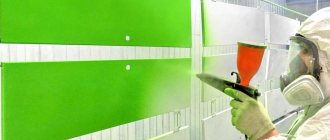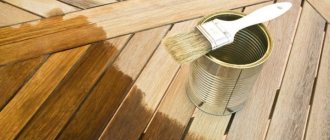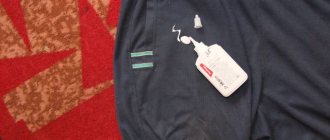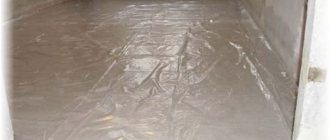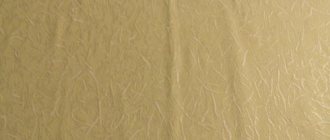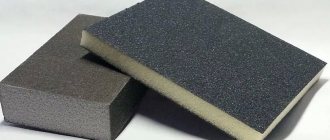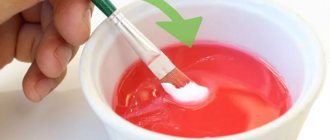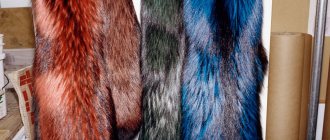The nuances of cleaning fabric from paint at home
In order for the process of removing such stains to be successful, it is important to consider the following nuances:
- Damaged material to be worked with;
- When exactly did the pollution appear?
- What kind of paint was it?
These features will allow you to choose the most suitable stain removal product and reduce the risk of fabric damage. And you should also adhere to the following recommendations:
- Fresh stains must be removed quickly. A solution of water with laundry soap or powder is suitable for this;
- Dried things are more difficult to wipe off. You will need to use a special chemical solution. You may have to repeat the procedure several times. Old dirt is difficult to remove;
- Determining the type of fabric will allow you to more effectively deal with the problem. It is better to test the selected composition on a small area of the material from the wrong side. It is better to dilute highly concentrated products with water;
- It is necessary to remove the stain starting from the edges, moving closer to the center. This will avoid expanding the affected area;
- At the end of the process, the item is washed in the usual way.
Features of cleansing depending on color
When choosing how to remove paint, you need to take into account not only the type, but also the color of the fabric.
White
When processing such clothing, care must be taken, because... solvents, benzine, or turpentine may leave yellow or gray streaks
To remove colored droplets, it is recommended to use ammonia, heated alcohol or hydrogen peroxide. A blot from stamp paint, watercolor paint, or gouache can be sprinkled with baking soda, salt, or crushed chalk.
If this does not help, mild chlorine or optical brighteners are acceptable. At the same time, you should not wash a white down jacket in “Whiteness”. The fabric will quickly turn yellow.
Black
To clean dark material, purified gasoline, turpentine or acetone are suitable. Fresh stains can be removed with laundry soap.
Bleach, baking soda, alcohol or solvents will leave bleached areas and should not be used.
How to get rid of old stains
Dried, old paint is stronger and more reliable. Therefore, it is more difficult to get rid of it. The following recipes can help you cope with this problem at home:
- Kefir with a high percentage of fat content is mixed with vinegar and borax in equal proportions. The resulting composition is applied to the stain on both sides of the material, starting from the outside. It is important to place something under the fabric so that when working on the backside, the paint does not stain other items. The mixture is left for some time, then cleaned with a toothbrush;
- Turpentine will help you cope with the problem on natural fabrics. It is enough to apply it on a cotton pad and treat the damaged area on both sides. The procedure must be repeated several times;
- Vinegar, in the amount of 2 tablespoons, is combined with a tablespoon of salt and a small amount of ammonia. The resulting composition is wiped over the damaged area for about 7 minutes. Then clean with a brush;
- Add a liter of chlorine to 6 liters of water. Mix and immerse the item in this container. It is important that this method is suitable for white clothes. After soaking, boil a little and wash as usual;
- The problem area is wiped with hydrogen peroxide, then the area is covered with fresh lemon slices. After an hour, the clothes are washed;
- Tar soap. They carefully wipe the problem area.
The listed methods are not universal for any material. Therefore, you must use the chosen method carefully.
Old and withered: how to cope with a difficult task?
Old stains are those that were placed more than 3 hours ago and have already dried out. The exact curing time depends on the following factors:
- watercolor quality;
- room temperature.
After the dye has dried on the surface of the clothing, removing the stain can damage the structure of the fabric itself and discolor the prints.
For old stains, the following options are suitable:
- using hot vinegar (the acid contained in it corrodes the frozen mass);
- using a recipe based on baking soda, hydrogen peroxide and warm water;
- store-bought stain removers and bleaches.
The stain remover must be selected based on the shade of the clothing. Powder forms of such products require preliminary dilution with water to a paste.
When using a store-bought clothes cleaning product, it is important to follow the instructions for the product.
How not to damage clothes
Removing traces of paint without ruining clothes is quite a difficult task. It is necessary to consider all existing effective options, as well as take into account the type of material, nature of contamination and type of paint.
What to pay special attention to
Important nuances will allow you to better cope with the problem. You should pay attention to the following recommendations:
- A fresh stain is easier to remove. Do not delay removal;
- The selected product is pre-tested to avoid damage to the material;
- Chemicals are applied first from the wrong side;
- The rest of the clothing should be protected with dry wipes or a piece of cloth;
- When working with aggressive components and ingredients, be sure to use gloves.
Getting rid of fresh stains: urgent help
It has already been noted that a soap solution is a good remedy when the stain has not had time to dry. Soap can be replaced with washing powder. The stain is treated with the composition, then washed. To increase efficiency, it is worth adding a stain remover.
Important nuances
In the case of watercolors and gouache, removing paint from clothes is not difficult. Even a dried stain can be erased without much effort. The situation is much more complicated with water-based emulsion and other persistent compounds. In this case, it makes no sense to use powder and water. You will have to use solvents. For example, white spirit or gasoline. Numerous folk remedies will also help in solving the problem. Among them are lemon juice and even gel intended for washing dishes.
Immediately after identifying stains, you need to perform the following manipulations:
- Blot the problem area with paper or a napkin.
- Study the information indicated on the clothing label.
- Determine the type of coloring composition.
- Do not put off basic manipulations until later. If you don’t have time at the moment, you need to at least just soak the item in the chosen solution.
- When using aggressive agents, initially test them on an area that is not visible. If the material becomes deformed or fades, this solvent cannot be used. A safer composition should be selected.
- Work with solvent only in a well-ventilated area. We must not forget about safety measures. To avoid aggressive effects on the skin, it is recommended to wear gloves.
The sooner the work begins, the easier it is to clean the clothes and achieve the desired result. It is extremely important to prevent the substance from drying out and firmly attaching to the fabric fibers. It is especially dangerous for thin and delicate materials.
True, you can remove dirt from an item even if the stain has dried. In this situation, you will have to perform several manipulations and be patient. If the top layer can be scraped off, these actions must be performed without fail. True, the procedure must be carried out as carefully as possible.
Try to remove the paint from the product with a knife
Removing Oil Paint
The oily composition can be removed with a mixture of butter and washing powder. A tablespoon of each ingredient is enough. They are mixed until smooth and rubbed into the dirt. After 40 minutes, wash the item. For white cotton pants, a mixture of a liter of water, a bar of 72% soap and a tablespoon of soda is suitable. All components are mixed in an enamel bowl. The resulting solution is brought to a boil. Pants are lowered into it for 10 seconds.
Vegetable oil softens the coloring matter well. But the processing is carried out several times. A little oil is applied to the stain and cleaned with a brush. To remove greasy marks, use dishwashing detergent.
Refined gasoline, acetone, and kerosene perfectly remove traces of oil paint. You can use the liquid that is used to remove nail polish. Before using the selected product, it must be tested on a separate section of tissue.
Gasoline must be precisely purified, otherwise it will leave traces of it and the clothes will be permanently damaged.
Step-by-step removal instructions
To remove paint stains from clothes, you need to follow these steps one by one:
- When applying dirt to the surface, immediately turn the item inside out and place the damaged part under a strong stream of cold water.
- Use your hands to wring out the clothing and see if the stain is removed.
- If the manual mode does not help, it is necessary to use special cleaning products, starting with laundry soap, solvents, taking into account the characteristics of the damaged fabric and the paint applied to them.
- Next, be sure to put it in the washing machine, washing should continue until the stain completely disappears. Can be washed in standard mode
- After winning, you need to rinse thoroughly until the stain removers are completely removed.
To remove paint from clothes you don’t need any special knowledge or expensive products; you need to act quickly and know what substances to use to remove stains from clothes. You should never put things off for a long time, in which case it will only get worse and you will have to go to the dry cleaner and waste your money.
Video tutorial on removing paint from fabric
Each of us, at least once in our lives, has made repairs ourselves, or helped someone with it. So the phenomenon of paint stains on clothes is familiar to everyone. Although, you don’t have to be a painter or actively paint fences to experience first-hand what it’s like to remove paint from your pants. You might accidentally lean against a wall or sit on a bench that painters have just worked on. And our kids certainly won’t miss a freshly painted sandbox. Or during art classes they will paint not only paper, but also clothes. Of course, parents are upset when they see soiled clothes, but there is no need to make a disaster out of it. There are effective ways to remove paint from clothes. So, let's learn.
Removing acrylic paint
Fresh traces of acrylic can be easily removed using the method already described with powder or soap. The dirt washes off pretty quickly. In more complex cases, use a mixture of ammonia and vinegar. They are mixed in equal proportions. You can add a spoonful of salt to enhance the effect. The mixture is applied to the desired area and left for a couple of minutes. Then brush and wash.
If you need to remove traces of acrylic quickly, just spray glass cleaning liquid onto the paint. After 5 minutes, remove the composition.
Getting rid of watercolors
Watercolor is a water-soluble composition. Therefore, it is not difficult to get rid of it. It is enough to soak the item with a fresh stain in cold water for 20 minutes, then wash it. If the case is serious, then rub the desired area with laundry soap, cover both sides with film and leave for 3 hours. Afterwards, treat with a brush and reapply soap. Then they put the item in the washing machine, select the intensive mode, and pour 100 g of soda into the powder compartment.
Some types of watercolor are oil-based. In this case, add a small amount of dishwashing detergent to the water and soak the clothes.
Important Tips
To avoid harming things and your own health while removing stains, you must adhere to the following tips:
- Study the information on the item's label. This will allow you to choose the best paint remover.
- When working with chemicals, you need to protect your respiratory system and skin.
- Before applying the cleaning composition, scrape the stain. To do this, use a knife, scissors or a stiff brush.
- When removing a stain, you need to move in the direction from its edges to the center.
Dried paint is a persistent stain, so it can be completely removed not in one, but in several washing cycles.
Hair dye
Such contamination should be removed immediately. You can use any styling varnish. Such products contain special solvents that dissolve coloring components. If the stain has already dried, it will be more difficult to remove. Light colored items are soaked in bleach. Lemon juice will also work. It is mixed with water or lemon powder is used. This sachet requires 100 ml of liquid. After treating the area, leave the solution for half an hour. Colored and dark materials are wiped with vinegar. A stain remover suitable for a specific type of fabric will also work.
Fighting dried paint stains
Soaking will help quickly remove the water emulsion.
If the paint has dried completely, solvents alone will not be enough. First you need to get rid of the top layer of color on the material if possible.
To do this, separate the dirt with a spatula; the remaining residue can be removed with a piece of pumice. Just don't rub the pumice stone on a thin fabric.
Now you need to dissolve the remaining paint and remove it from the fibers. Alcohol or another suitable solvent will help clean the fabric. For bright, delicate fabrics, it is better to use a washing soap solution.
It is important that the contaminated area is saturated with the composition and the paint softens. Then all you have to do is lightly rub the stain and it will disappear.
